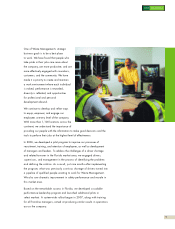Waste Management 2006 Annual Report Download - page 21
Download and view the complete annual report
Please find page 21 of the 2006 Waste Management annual report below. You can navigate through the pages in the report by either clicking on the pages listed below, or by using the keyword search tool below to find specific information within the annual report.
WASTE DISPOSAL
As the owner and operator of the
largest network of landfills in the
waste industry, Waste Management
safely, responsibly, and carefully
manages the disposal of more than
128 million tons of waste annually.
Our 283 active landfills currently
have an average remaining
permitted life of 28 years.
We continually work with
municipalities and regulatory
organizations to expand disposal
capacity at our existing sites and
to develop additional landfill sites.
Including expansions that we
believe are probable at 62 landfills,
the estimated average remaining
life of our landfills is 35 years.
A long-time developer of
advanced landfill management
methods, Waste Management
continues to lead the industry in
solutions that impact the future of
solid waste management, such as
Next Generation Technology.
SM
This alternative approach
accelerates the decomposition of
waste in landfills so that it occurs
within years rather than decades.
At the same time, the technology
speeds the production of landfill
gas, a renewable energy source.
Waste Management has 14 Next
Generation TechnologySM projects in
the U.S. and Canada, and continues
to work with the EPA and other
groups to develop the engineering
knowledge base and operational
expertise that will enable
widespread implementation.
• Extreme Makeover: Home Edition built a new home for two Philadelphia-
area grandparents who are raising three young grandchildren.
Waste Management donated hauling and disposal services for the week-
long project that involved demolishing the old home and constructing a
new one in a very short time frame.
• In an episode of Project Runway titled “Waste Not, Want Not,” contestants
visited a Waste Management Recycle America facility to gather materials
to use in original dress designs. After the airing, we purchased all of the
dresses and donated them to nonprofit organizations across the country.
They, in turn, benefited by raising thousands of dollars through auctions
or by using the dresses to generate publicity.
• On Thanksgiving Day, the 22nd annual Waste Management Houston
Thanksgiving Superfeast fed 20,000 homeless and less fortunate citizens.
More than 2,000 volunteers served 8,000 pounds of turkey with all the
trimmings, and also distributed clothing and blanket donations.
On a daily basis, Waste Management drivers and dispatchers participate
in a neighborhood safety program called Waste Watch, assisting local
police by observing streets, alleys, and properties as they run their routes.
They are trained to watch out for the safety of neighborhoods and businesses,
often at times when criminal activity or emergency situations might go
unnoticed. Stories abound of Waste Management drivers who have provided
assistance when needed, alerted emergency personnel, or performed heroic
acts of rescue.
Promoting the health and well-being of all our neighbors is one of the
ways we prove ourselves to be a trusted and valued community partner.
That’s Green at Work.
19
























